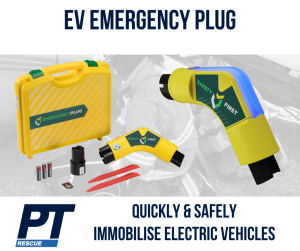The EV Emergency Plug enables safe working on and around electric and hybrid vehicles.

An electric or plug-in vehicle will not turn off if you release the clutch, and you cannot hear the engine running, which differs significantly from a vehicle with a conventional internal combustion engine. In many electric vehicles, the motor might switch off in some high impact collisions, provided the backup safety systems are working effectively, but there is no guarantee, especially if these systems might be damaged by the collision, and in minor incidents, the collision impact might not be great enough to trigger the deployment of internal immobilisation device but still require emergency response intervention. In such instances, it is difficult for the first responder to determine whether or not the ‘high Impact effect or kinetic energy’ was sufficient to immobilise the vehicle and whether or not the safety systems on board have been activated to immobilise the vehicle.
The initial important task of a first responder in an accident with a hybrid or plug-in vehicle is to make the vehicle safe for rescue operations. The recommended procedure to secure the vehicle, following the Emergency Response Guide, is to ensure that the transmission is set to ‘park’, turn off the vehicle by pushing the On/Off button and remove proximity keys. The next step in making the EV safer to work around is for first responders to isolate the low voltage (LV) & high voltage (HV) systems by way off disconnecting the 12V battery and HV Responder by cutting the loops and pulling fuses. These batteries, loops and fuses are located inside the vehicle under the bonnet or inside the boot, which places rescue teams in the danger zone of unstabilised vehicle movement as there is a significant risk that the emergency responder will be injured if the vehicle accelerates unintentionally before these procedures can take place.
The Emergency Plug offers a solution to work safely around hybrid and electric vehicles whilst following Standard Operating Procedures (SOP’s) or safety protocols to immobilise a vehicle involved in a collision or rescue situation.
By inserting the Emergency Plug into the vehicle charging port the vehicle can no longer move. The rescuer can safely walk around the vehicle after the emergency plug has been engaged. By inserting the Emergency Plug into the charging port of the vehicle, the plug creates the impression to the software of the vehicle that the car is charging at a charging station. The Emergency plug capitalises on a global safety standard whereby every electric vehicle around the world is required to have safety software installed that sends a signal to the vehicle control system to let the vehicle know when it is charging and disable the ability for that vehicle to drive whilst being charged. Simply inserting the Emergency Plug into the charging point of the vehicle, replicates this condition to effectively disable and immobilise the vehicle, creating a safe environment for emergency responders and bystanders who are in the vicinity.
The Emergency Plug also allows for the 12v battery system to remain live if required. This allows for the continued operation of some electrical functions such as the operation of doors, windows or seats during rescue operations, providing an advantage to first responders in terms of patient access and extrication.
The Emergency Plug is universal and suitable for every electric or plug-in hybrid vehicle with a type 1 or type 2 connection. The Emergency Plug also provides first responders with a visual confirmation that the vehicle is safe to work on, as the inbuilt luminescent edge of the device glows blue when an electric vehicle is communicating with the Plug, illustrating that the vehicle is in “safe mode” and is incapable of driving.
The Emergency plug also features a self-test function that enables first responders to quickly verify that all vehicle disabling software is working correctly. When operating correctly, the edge of the Emergency Plug lights up with a green signal to indicate that the system is communicating effectively.
Unlike an e-vehicle charging plug, the Emergency Plug is not locked against removal. Typically, when a charging plug is inserted the system will lock the plug in place. The benefit of the Emergency Plug not locking into the port of the vehicle is that it remains removable, even if the 12v volt system is disengaged.
The Emergency Plug also has a sensor function for opening the charging port cover of Tesla models as they open electronically. Pressing the self-test button sends out a signal to the Tesla charging port which opens the port cover to gain access. As advances in software technology are continually being developed, The Emergency Plug has the ability to update internal software to accommodate these changes as new vehicles are released to the market.
The Emergency Plug is a practical solution for use by all rescue and emergency service agencies.
Police – If police are the first to arrive at the scene of an incident, police personnel can quickly and easily insert the Emergency Plug to imobilise the vehicle. The Emergency-plug can be used whenever it is necessary to ensure a safe situation both for first responder and any bystanders. When conventional-fuel driven or ICE vehicles are being put to a stop, police usually request the driver to place the vehicle in ‘Park’ and turn off the engine. However, it can be extremely difficult to determine whether this request has transpired if an E-car or Hybrid is involved. When police require an electric vehicle to be stopped, the officer can simply place the Emergency Plug in the charging socket of the vehicle for the duration that the vehicle is required to be immobilised and remove it once the driver is able to continue.
Rescue & Ambulance – When a driver has become incapacitated in an electric vehicle, it is extremely important for rescue crew or ambulance personnel to have safe access to the patient without the risk of vehicle movement once the door has been opened or access to the cabin is gained. If Ambulance personnel are the first, or potentially only, emergency rescue personnel to arrive on the scene; they can quickly deploy the Emergency Plug, saving valuable time to secure the vehicle and deliver emergency treatment.
Other Agencies – Other agencies that may benefit from use of the Emergency Plug to immobilise electric and hybrid vehicles including, towing services, break-down recovery services and road inspection agencies. To facilitate their work, these personnel also need to ensure that vehicles being towed, or assisted for roadside breakdown are safely immobilised and do not present a safety hazard to attending personnel. As the Emergency Plug can easily be deployed under such conditions, it represents an effective means of ensuring the safety of not only the attending but also the vehicle itself, its occupants, and surroundings.

